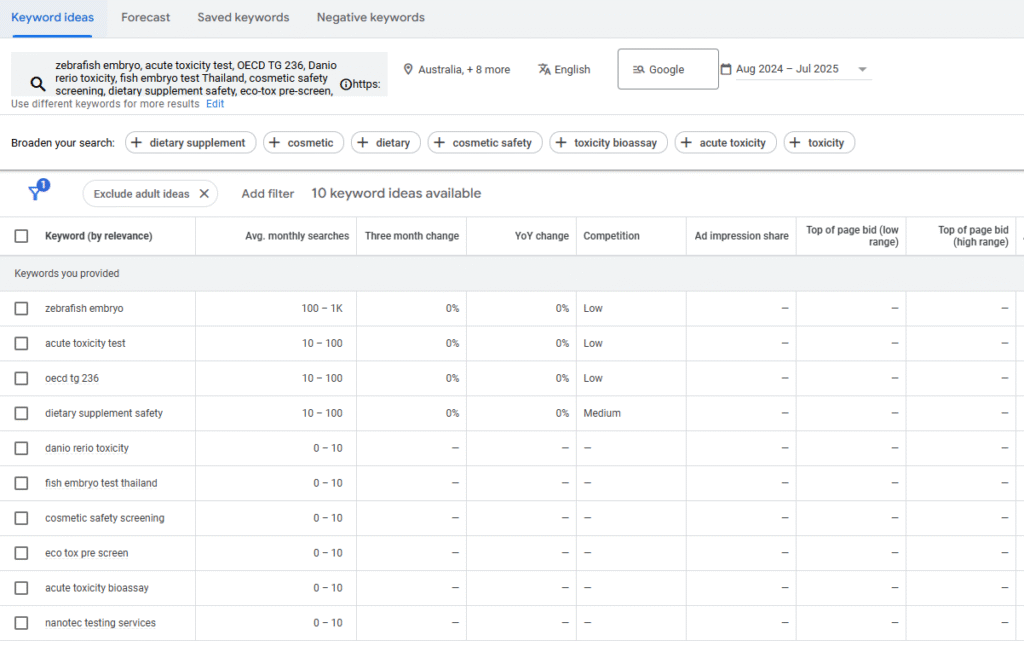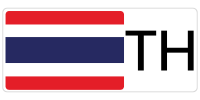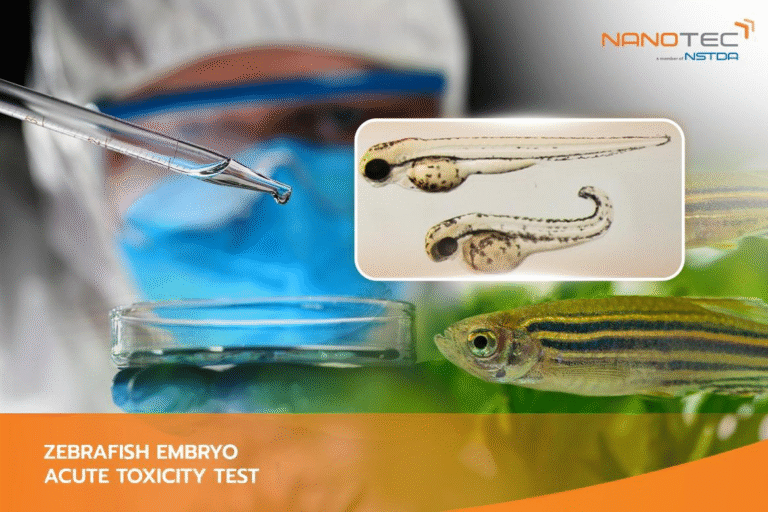Meta description (140–160): Fast, visual, and guideline-aligned. NANOTEC’s zebrafish embryo acute toxicity test (OECD TG 236) screens liquids or powders in 96 hours to flag acute hazards for cosmetics, supplements, and chemicals.
SEO keywords: zebrafish embryo, acute toxicity test, OECD TG 236, Danio rerio toxicity, fish embryo test Thailand, cosmetic safety screening, dietary supplement safety, eco-tox pre-screen, acute toxicity bioassay, NANOTEC testing services, R&D QA compliance

Why This Test Matters
Early, evidence-based toxicity screening saves time, money, and reputation. The zebrafish embryo acute toxicity test provides a rapid, vertebrate-based look at acute hazard potential using transparent embryos that develop quickly and predictably. Because the assay adheres to OECD Test Guideline 236, your data maps to an internationally recognized framework-useful for technical files, partner due diligence, or internal go/no-go gates.

Compared with traditional mammalian tests, zebrafish embryos offer:
- Speed: Typical exposure lasts up to 96 hours, with clear observation windows and defined endpoints.
- Throughput & Visibility: Multiple embryos per condition and transparent development make effects straightforward to monitor.
- Standardization: A widely referenced OECD method with consistent endpoints and reporting.
- Practical cost profile: A focused way to de-risk new ingredients, botanical extracts, or finished products before larger studies.
Whether you’re developing cosmetics and personal care, nutraceuticals/dietary supplements, or evaluating chemical ingredients and intermediates, this assay lets you triage candidates quickly and build a defendable safety narrative early in development.
What the Test Measures (OECD TG 236, Acute Toxicity)
Principle. Fertilized zebrafish eggs/embryos are exposed to the test item at defined concentrations under controlled conditions. Over up to 96 hours, embryos are observed for guideline-defined lethal/morphological endpoints indicating acute toxicity. The study can be configured as a limit test (one concentration) or a concentration–response test (tiered levels) depending on your decision needs.
Typical outputs you receive:
- Acute toxicity outcome under test conditions (toxic / non-toxic), aligned to OECD TG 236 criteria.
- Observation table by timepoint (e.g., 24, 48, 72, 96 h), noting guideline endpoints per concentration (if tiered).
- Concentration context (limit test vs. series); optional estimation of an effect concentration (e.g., LC₅₀) when a series is agreed in scope.
- Method summary (exposure design, environmental conditions, observation intervals).
- Interpretive note (e.g., “meets your internal acceptance limit” or “additional narrowing around X–Y mg/L recommended”).
If you maintain house limits or acceptance bands, share them with us-we can apply pass/fail flags directly in the report.
How We Plan the Study
- Scoping & Design
- Define test objective (limit vs. concentration–response).
- Confirm test matrix (liquid, powder) and any constraints (pH, solubility, light sensitivity).
- Set observation schedule and endpoints per OECD TG 236.
- Note any acceptance criteria you use (for QA or partner files).
- Execution
- Prepare exposure media and embryos; conduct exposures under controlled temperature and lighting.
- Record timepoint observations using the TG 236 criteria.
- Optional: photo documentation of representative embryos/conditions.
- Quality & Reporting
- Check data integrity and completeness.
- Compile a decision-ready report with results summary, tables, and method details.
- Provide recommendations for retest, narrowing ranges, or next steps (e.g., in-vitro genotoxicity).
Reporting You Can Use
Your package is concise and audit-friendly:
- Results summary (toxic / non-toxic; or concentration–response outcome)
- Observation tables by timepoint and concentration (if applicable)
- Notes on any confounders (e.g., precipitation, strong coloration) and how they were managed
- Method summary (OECD TG 236 framework, exposure duration up to 96 h, environmental controls)
- Pass/Fail flags vs. your acceptance levels (if provided)
- Optional photographs captured under standardized conditions
Report language & delivery
NANOTEC issues decision-ready test reports in Thai or English (one language included). A second language copy can be provided for an additional THB 500. Reports can be delivered by hand, via email, or by post (postal delivery incurs an additional shipping charge).
Sample Guidance (Get Valid, Reproducible Data)
To reduce ambiguity and retests, please prepare samples as follows.
Accepted forms & quantities (per sample):
- Liquids: 100 mL
- Powders: 60 mg
Labeling & documentation:
- Identify each container with sample name, lot/batch, and intended test (“OECD TG 236”).
- Include SDS and any handling notes (e.g., irritant, oxidizer, volatile, light-sensitive).
- Share known solubility constraints or pH stability windows. If a vehicle or gentle solubilization is required, we’ll agree the approach before study start.
Shipping & storage:
- Pack securely to avoid leaks or contamination.
- If the material is temperature-sensitive, indicate preferred storage and ship accordingly (e.g., cool pack).
Planning multiple assays (e.g., acute zebrafish test + in-vitro cytotoxicity)? Send sufficient material to cover all runs and contingencies so we can keep your timeline tight.
Sample return & storage
After testing, you may choose to have remaining samples destroyed or returned. Returned samples can be picked up in person or shipped by post (shipping charge applies). If samples are not collected within 30 days of report delivery, NANOTEC will dispose of them. During intake, storage conditions are recorded (e.g., room temperature, chilled, desiccator).
Who This Service Is For
- Cosmetics & personal care developers (actives or finished products) seeking a vertebrate-model acute toxicity screen early in development.
- Dietary supplement/nutricosmetics teams that need fast hazard signals for extracts or new actives.
- Chemical suppliers and formulators who want a quick eco-tox pre-screen before deeper regulatory dossiers.
- QA/Regulatory groups compiling safety evidence for partner review or market expansion.
- Academic and industry consortia mapping hazard profiles across candidate libraries under a standard guideline.
Complementary & Follow-On Tests
- In-vitro Cytotoxicity (ISO 10993-5) – cell viability and IC₅₀ estimation to contextualize dose windows for raw materials, botanical extracts, or finished products.
- In-vitro Micronucleus (OECD 487) – genotoxicity screen at the chromosomal level.
- Zebrafish Melanin-Inhibition (in-house) – for pigmentation-related bioactivity while checking for acute toxicity over ~48 h.
- Chemistry & Stability – if needed, pair your bioassay with FTIR/GC-MS checks or stability studies to understand degradation and impurities that may influence toxicity readouts.
These modules help convert an isolated hazard signal into a coherent safety story suitable for decision meetings and partner submissions.
Pricing Overview
- Zebrafish embryo acute toxicity (OECD TG 236): from THB 100,000 per sample (excl. VAT)
Notes:
Final quotation depends on scope (limit test vs. concentration–response), documentation depth, and any optional add-ons (e.g., image sets). We’ll confirm everything at scoping so expectations, timelines, and budgets are aligned.
How to Get Started
- Share your objective (limit vs. dose–response; acceptance limits if any).
- Send sample details (form, stability/handling, expected concentration window).
- Receive a plan & quote (design, observation schedule, reporting).
- Ship samples (see quantities above); we schedule your study and keep you updated.
- Review your report and decide next steps (e.g., refine ranges or add genotox).
Suggested Internal Links
- In-vitro Cytotoxicity (ISO 10993-5) – cell viability & IC₅₀
- In-vitro Micronucleus (OECD 487) – genotoxicity at the chromosomal level
- Zebrafish Melanin-Inhibition (In-house Method) – pigmentation bioactivity + acute toxicity observation
- Chemical & Physical Analysis Hub – particle size, microscopy, FTIR/GC-MS, contact angle
- Stability & Shelf-Life Services – to understand formulation robustness over time
Contact
National Nanotechnology Center (NANOTEC) – Infrastructure Services
143 INC 2 (B), Thailand Science Park, Phahonyothin Road,
Khlong Nueng, Khlong Luang, Pathum Thani 12120, Thailand
Tel. +66 2 564 7100 ext. 6517, 6625, 6680
Email: bdis-infs@nanotec.or.thMake earlier, safer decisions. OECD TG 236 with zebrafish embryos gives you a clear acute toxicity read-fast-so you can prioritize the safest, most promising candidates for further development.


